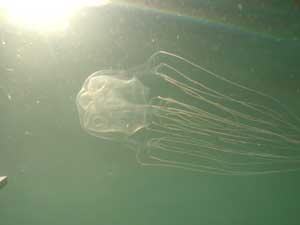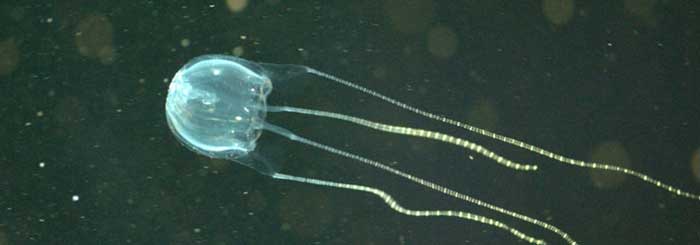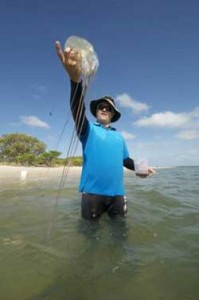The Great Barrier Reef is full of amazing and beautiful creatures but some of them are best observed from a distance, including the fascinating but extremely dangerous Australian box jellyfish.
November is the start of the ‘stinger’ season in North Queensland. Stingers are the name commonly given to jellyfish in Australia.
 Relatively little is known about these strange venomous sea creatures but Jamie Seymour, Associate Professor at the Australian Institute of Tropical Health and Medicine and James Cook University in Cairns, is leading the way to finding out more.
Relatively little is known about these strange venomous sea creatures but Jamie Seymour, Associate Professor at the Australian Institute of Tropical Health and Medicine and James Cook University in Cairns, is leading the way to finding out more.
We caught up with Jamie recently to talk about stingers. It has to be said that we didn’t realise beforehand just how interesting jellyfish were. As it turned out we discovered a lot of fascinating facts:
1. There are 29 different species of box jellyfish
The most publicised and well known are the big box jellyfish (most deadly) and the irukanji jellyfish and then there are 27 other lesser well known species. In North Queensland the big box jellyfish and the irukanji are the most common jellyfish seen during ‘stinger season’.
2. The big box jellyfish is the most venomous on the planet
It is so venomous it will kill you within two minutes if you receive two metres or more tentacle contact. If a tentacle touches the skin it results in a very painful sting.
3. All jellyfish are venomous
All jellyfish will sting you with venom if their tentacles come in contact with you but only about eight or nine species of jellyfish are dangerous.
4. A box jellyfish sting results from venom being released from the tentacles
Jellyfish have 800,000 stinging organelles per square centimetre on their tentacles, which can only be seen under a microscope. When a jellyfish touches another animal or person the organelle sticks in their skin and fires off venom.
 5. Irukanji Syndrome is a term used to describe a series of symptoms from a box jellyfish sting
5. Irukanji Syndrome is a term used to describe a series of symptoms from a box jellyfish sting
These symptoms include vomiting, headaches, agitation, profuse sweating, rapid heart rate and very high blood pressure.
6. Turtles are the only jellyfish predators
Thanks to a thick skin, turtles are not affected by box jellyfish stings. In fact, only their eyes can be stung.
7. Big box jellyfish have 24 eyes
This is probably one of the more bizarre things we learned about jellyfish. Apparently their eyes are on the side of their body and all look inwards as they use their body as a lens to see through. Their eyes are grouped in six lots of four eyes.
8. Jellyfish are fast swimmers
Studies show that big box jellyfish can swim faster than any Olympic swimmer.
Scientists have only recently learned that jellyfish settle on the bottom of the ocean floor at night to sleep and then feed during the day.
10. Jellyfish shrink if they don’t eat
Jellyfish usually eat two to three times a day. Small jellyfish eat prawns and big box jellyfish eat fish. However, if they don’t eat they shrink. A big box jellyfish can lose up to 30 per cent of its bodyweight in 24 hours if it doesn’t eat. Consequently the best way to tell the age of a jellyfish is by measuring their eyes and not by the size of their body.
11. Jellyfish live for about three months
In the open ocean, jellyfish only live for a period of about three months but they can sometimes live for up to seven to eight months in a science lab tank.
12. Stinger suits or wetsuits can prevent stings
If your skin is protected by clothing it removes the biological taste so jellyfish can’t tell you’re an animal and won’t fire off venom. Our biggest lesson from talking to Jamie? Always wear a stinger suit during stinger season even if they do make you look silly!
13. In the event of a box jellyfish sting, clear airways and check breathing and circulation
While the Australian Resuscitation Council recommends applying vinegar to jellyfish stings, some researchers disagree. Jamie says that his research shows that applying vinegar is a double-edged sword. Vinegar deactivates stinging organelles that haven’t yet fired off venom, but if the organelle has already fired off then the use of vinegar causes it to squeeze out more venom into the body.
14. Not all jellyfish stings are the same
If you get a big box jellyfish sting the pain is immediate and there is no pain relief. The most important things is to keep the heart pumping. An irukanji sting is slightly different – there will usually be about a 20 minute delay before the symptoms of vomiting, headaches, sweating, rapid heart rate and high blood pressure kick in.
15. Global warming is causing the stinger season to extend
The Australian box jellyfish season now runs from November through to July in Cairns, whereas it previously only lasted until May. As sea temperatures are increasing, so too is the occurrence of jellyfish.



